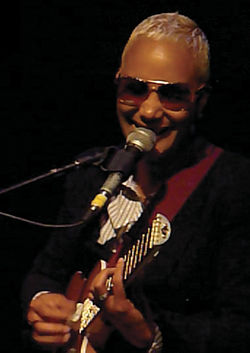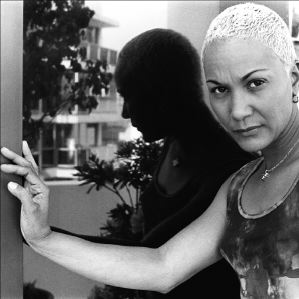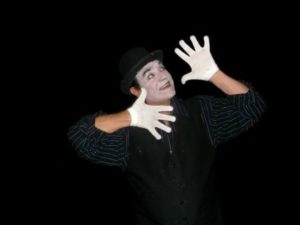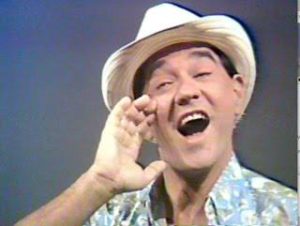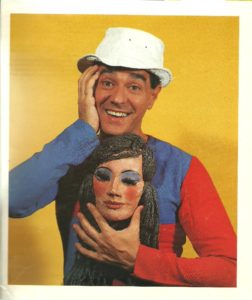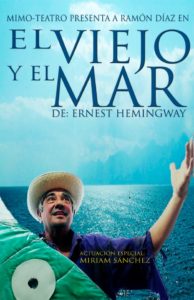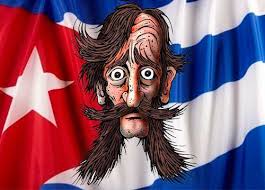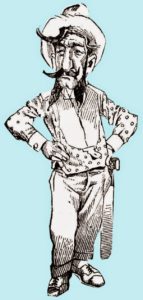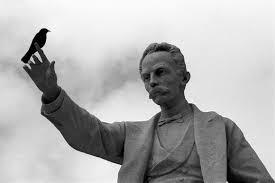 NIURKA CURBELO, CANTANTE, PRODUCTORA, COMPOSITORA. VIDEOS.
NIURKA CURBELO, CANTANTE, PRODUCTORA, COMPOSITORA. VIDEOS.
Niurka Curbelo es una cantautora y productora y entrenadora musical independiente, nacida en la Ciudad de La Habana, Cuba un 2 de Junio de 1966. Inició su carrera artística de manera autodidacta con tan solo 7 años.
Compone su 1era canción “Palmera” a los 9 años y estudia guitarra y tres cubano junto al maestro Cotan. Fueron varios los premios y reconocimientos obtenidos mientras estudia Guitarra Clásica en el Conservatorio Alejandro García Caturla y en la ENA (Escuela Nacional de Arte).
A los 16 años integra el Movimiento de la Nueva Trova y años más tarde crea el grupo musical SOS. En el año 1992 ingresa a la Fundación Pablo Milanés con su grupo femenino Azúcar Latina, una de las primeras agrupaciones femeninas en el ámbito musical cubano y comienza a realizar una serie de conciertos en los foros más importantes, entre ellos: el Teatro Nacional de Cuba, el Museo Nacional de Bellas Artes. Entre otras de sus actividades, trabaja durante cinco años como Terapeuta Musical en la escuela para niños con discapacidad intelectual La Castellana, donde aprende a ver la vida desde el ángulo humanitario.
El 23 de junio del 2000 es invitada a compartir escenario junto el grupo español Presuntos Implicados en el Auditorio Nacional de la Ciudad de México. Participa nuevamente con gran aceptación en el Festival Cultural del Barrio Antiguo de Monterrey.
En el 2001 Niurka da a conocer “Todo podría cambiar” bajo la producción de Nacho Mañó, donde interpreta a dueto el tema de su inspiración Juro, junto a la cantante Soledad Giménez, vocalista del grupo español Presuntos Implicados, éste material la consolida en el panorama cantautoral obteniendo así una gran aceptación y reconocimiento por parte del público. También en el 2001 interpreta junto a el cantautor Edgar Oceransky en su primer material discográfico (llamado “Estoy aquí” bajo el sello Sony Music) el tema ¨Imágenes de Ana¨.
Graba el Concierto Total con el canal de videos de mexicano Ritmo son Latino, el cual es difundido en América Latina, Estados Unidos y España. Realiza un concierto masivo en la Macroplaza (Explanada de los Héroes) dentro del Festival Cultural del Barrio Antiguo de la ciudad de Monterrey.
Hacia el 2002 es nominada a los Premios Lucas de Cuba en la categoría video pop femenino. Participa nuevamente en el Festival Cultural del Barrio Antiguo de la ciudad de Monterrey en Mexico.
En el 2003 graba en EUA el disco “Mala manía” bajo la producción de Hal S. Batt (Productor Musical de Julio Iglesias) y se reencuentra con su compañera de escuela Alma Rosa Castellanos, deciden unir sus voces y surge el proyecto Santamorena, dueto acústico a guitarra y voz.
En el 2004 se estrena como Productora Musical, lanzando de manera independiente el disco “Alma y Niurka”, grabado en vivo en el SOB’S, el club más importante de World Music en New York y realiza presentaciones importantes en el club de jazz Blue Note NY y otras ciudades de EUA. También participan como artistas invitadas y actrices en la comedia musical “Entiéndeme tu a mi” de Eloy Arenas, dirigida por el actor y director español Juan Manuel Cifuentes, e interpretada por el actor venezolano Raúl Gonzalez (Locutor de Despierta América), el actor puertorriqueño Pedro Telemaco, puesta en escena en el Teatro Venevisión Internacional de Miami.
Entre el 2005 a 2007 – Santamorena realiza la gira “Tour Acoustic Voices” por Francia, España, Suiza, Italia, Ámsterdam, Alemania, Tunisia, Holanda, Marruecos, Portugal, compartiendo escenario junto a la Orquesta Sinfónica de la Ópera de Paris (ante 40,000 personas en el Festival Violon Sur Le Sable), junto Raúl Paz (Cuba) en el Elysee Montmartre de Paris, Femi Kuti (Nigeria), Souad Massi (Algerina) y muchos más. También comparten escenario en el Festival Latinos Tabarka junto a Son Trinidad (Cuba), Los Bucaneros (Brasil). En 2009 crea y comienza a grabar el disco Santamorena Band, grupo femenino integrado por 6 talentosas mujeres y realiza una gira por las principales ciudades de EUA y también gira por EUA tocando el bajo junto a la cantautora María Isabel Saavedra (compositora colombiana de temas interpretados por Óscar de León, La India, entre otros).
En el 2011 renueva Santamorena y regresa al formato de dueto junto a la cantautora mexicana Ivette Guadarrama, graba nuevo disco “Abre la puerta” producido por el cantautor nominado al Grammy Edgar Oceransky, comenzando una gira como artistas invitadas de Reyli Barba y Edgar Oceransky llamada “Sumando Amor” por las ciudades más importantes de México. Dos anos despues (2013) retoma su carrera de solista y realiza la gira “Compositores más que cómplices” por toda la república mexicana junto a Omar Aldama, Jaime Flores y Bruno Danzza.
Ha compartido escenario con otros grandes de la música como Yordano D’ Marzo, Locos por Juana, DJ Spam, Susana Zabaleta, Aranza, Tania Libertad y muchos más y ha escrito canciones junto a Luis Enrique (El Príncipe de la Salsa), Fernando Osorio (compositor de La negra tiene tumbao) y para intérpretes como Aranza (México), Sol (Argentina), Estrella (México), tercer lugar de la primera generación de La Academia, Melina León (Puerto Rico), Aristía (Chile), etc.
Las canciones de Niurka pueden ser descritas como algo absolutamente emocional y lleno de amor.
Como solista, productora y compositora ha expuesto su talento en diferentes proyectos y grandes escenarios que han hecho de Niurka Curbelo una figura representativa. Niurka, es una excelente cantautora y músico, una intérprete con propuesta real, llena de talento, sensibilidad y credibilidad, además de una gran fuerza escénica y la sensualidad de una mulata cubana que se conjuga con sus dotes excepcionales para tocar la guitarra.
Durante estos años su trabajo como compositora ha recibido grandes logros puesto que artistas como la cantante mexicana Aranza y la cantante merenguera puertorriqueña Melina León le interpretan diferentes temas logrando así un mayor reconocimiento como compositora. Ha llevado su música con gran éxito a España, EUA, Colombia, Cuba y México.
Reside actualmente en Puerto Vallarta, Mexico.
Discografía
Ultimas Presentaciones.
2004 – Alma y Niurka – Grabado bajo la producción de Niurka Curbelo y SOB’S New York
2009 – Santamorena Band- Grabado bajo la producción de Niurka Curbelo y Sergio López (Independiente)
2011 – Abre la puerta – Grabado bajo la producción de Edgar Oceransky (Independiente)
Colaboraciones
2001 – “Juro” – Dueto con Sole Giménez en el disco ‘Todo podría cambiar’
2001 – “Imágenes de Ana” – Dueto con Edgar Oceransky en el disco ‘Estoy aquí’
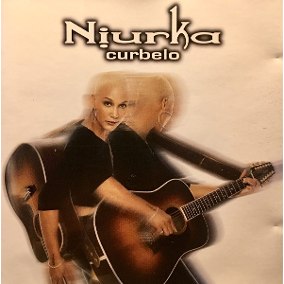 NIURKA CURBELO, SINGER, PRODUCER, COMPOSER. VIDEOS.
NIURKA CURBELO, SINGER, PRODUCER, COMPOSER. VIDEOS.
Niurka Curbelo is an independent singer-songwriter and music producer, born in the City of Havana, Cuba on June 2, 1966. She started her artistic career in a self-taught way with only 7 years.
She composed his first song “Palmera” at the age of 9 and studied guitar and three Cuban songs with maestro Cotan. There were several awards and recognitions obtained while studying Classical Guitar at the Alejandro García Caturla Conservatory and at the ENA (National School of Art).
At the age of 16, she joined the Nueva Trova Movement and years later created the SOS musical group. In 1992 she joined the Pablo Milanes Foundation with his female group Azúcar Latina, one of the first female groups in the Cuban musical sphere and began to perform a series of concerts in the most important forums, among them: the National Theater of Cuba, the National Museum of Fine Arts. Among other activities, she works for five years as a Music Therapist at the school for children with intellectual disabilities La Castellana, where she learns to see life from the humanitarian angle.
On June 23, 2000, she was invited to share the stage with the Spanish group Presuntos Implicados in the National Auditorium of Mexico City. Participates again with great acceptance in the Cultural Festival of the Old Quarter of Monterrey.
2001 – Niurka announces “Everything could change” under the production of Nacho Mañó, where she plays the duet of his inspiration Juro, along with the singer Soledad Giménez, vocalist of the Spanish group Presuntos Implicados, this material consolidates it in the panorama cantautoral obtaining a great acceptance and recognition by the public. Also in 2001, he performed together with the singer-songwriter Edgar Oceransky in his first album (called “Estoy aquí” under the Sony Music label) the song “Ana images”.
Record the Total Concert with the video channel of Mexican Ritmo son Latino, which is broadcasted in Latin America, the United States, and Spain. Make a massive concert at the Macroplaza (Esplanade of Heroes) within the Cultural Festival of the Old Quarter of the city of Monterrey.
By 2002 she is nominated for the Lucas de Cuba Awards in the female pop video category. Participates again in the Cultural Festival of the Old Quarter of the city of Monterrey in Mexico.
In 2003 she records in the USA the album “Mala manía” under the production of Hal S. Batt (Musical Producer of Julio Iglesias) and he reunites with her schoolmate Alma Rosa Castellanos, they decide to join their voices and the ‘Santamorena’ project arises, duet acoustic to guitar and voice.
In 2004, she premiered as a Music Producer, independently releasing the album “Alma y Niurka”, recorded live at SOB’S, the most important club in World Music in New York and making important presentations at the Blue Note NY jazz club. and other US cities. They also participate as invited artists and actresses in the musical comedy “Entiéndeme tu a mi” by Eloy Arenas, directed by the Spanish actor and director Juan Manuel Cifuentes, and performed by the Venezuelan actor Raúl Gonzalez (Announcer of Despierta América), the Puerto Rican actor Pedro Telemaco, staged at the Venevisión International Theater in Miami.
Between 2005 to 2007 – ‘Santamorena’ performs the tour “Tour Acoustic Voices” for France, Spain, Switzerland, Italy, Amsterdam, Germany, Tunisia, Holland, Morocco, Portugal, sharing the stage with the Paris Opera Symphony Orchestra (before 40,000 people at the Violon Sur Le Sable Festival), along with Raúl Paz (Cuba) at the Elysee Montmartre in Paris, Femi Kuti (Nigeria), Souad Massi (Algerina) and many more. They also share a stage at the Latinos Tabarka Festival with Son Trinidad (Cuba), Los Bucaneros (Brazil). In 2009 he created and began to record the album Santamorena Band, a female group composed of 6 talented women and toured the main cities of the USA and also toured the US playing the bass along with singer-songwriter María Isabel Saavedra (Colombian composer of interpreted songs by Óscar de León, India, among others).
In 2011 ‘Santamorena’ renews and returns to the duet format with Mexican singer-songwriter Ivette Guadarrama, records new album “Abre la puerta” produced by Grammy-nominated singer-songwriter Edgar Oceransky, beginning a tour as guest artists of Reyli Barba and Edgar Oceransky called “Sumando Amor” for the most important cities in Mexico. Two years later (2013) he resumed his solo career and made the “Composers more than accomplices” tour throughout the Mexican Republic with Omar Aldama, Jaime Flores, and Bruno Danzza.
She has shared the stage with other greats of music such as Yordano D ‘Marzo, Locos por Juana, DJ Spam, Susana Zabaleta, Aranza, Tania Libertad and many more and has written songs with Luis Enrique (The Prince of Salsa), Fernando Osorio (composer of La negra has tumbao) and for performers like Aranza (Mexico), Sol (Argentina), Estrella (Mexico), third place of the first generation of La Academia, Melina León (Puerto Rico), Aristía (Chile), etc.
The songs of Niurka can be described as something absolutely emotional and full of love.
As a soloist, producer, and composer she has exhibited her talent in different projects and great scenarios that have made Niurka Curbelo a representative figure. Niurka, is an excellent singer-songwriter and musician, an interpreter with a real proposal, full of talent, sensitivity, and credibility, as well as a great scenic force and the sensuality of a Cuban mulatto girl who combines with her exceptional skills to play the guitar.
During these years, her work as a composer has received great achievements since artists such as the Mexican singer Aranza and the Puerto Rican singer Merenguera Melina León interpret different themes, thus achieving greater recognition as a composer. He has brought his music with great success to Spain, USA, Colombia, Cuba, and Mexico.
Resides currently in Puerto Vallarta, Mexico.
(READ NIURKA CURBELO PERFORMANCES IN THE SPANISH SECTION)
Agencies/ ZonaAcustica/ Wiki/ Internet Photos/ YouTube/Arnoldo Varona/ www.TheCubanHistory.com
THE CUBAN HISORY, HOLLYWOOD.



